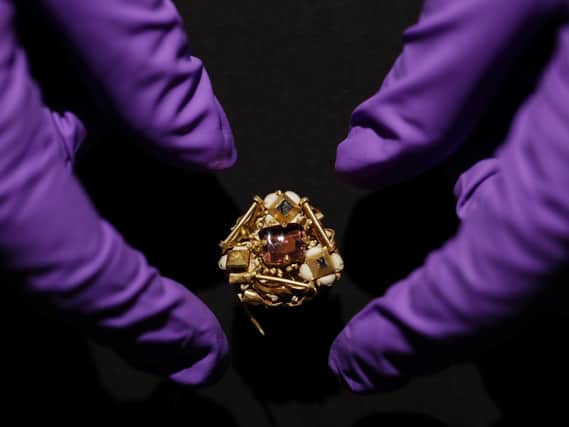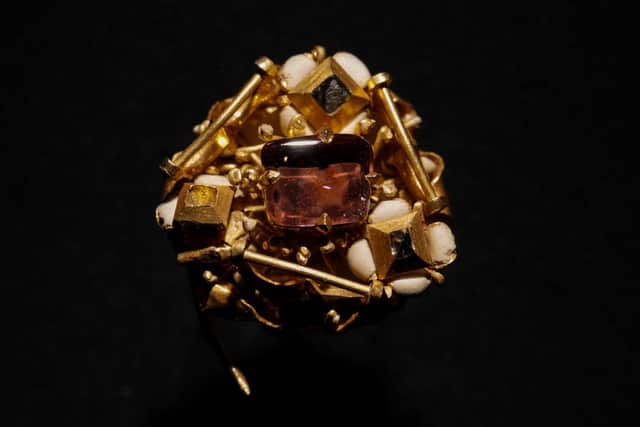'Intriguing' and 'exquisite' Brigstock treasure to star at museum and on TV


A priceless piece of medieval jewellery that was dropped 600 years ago by a wealthy horse rider in a field near Brigstock has gone on show today at London's V&A museum.
The triangular shaped gold, diamond and pearl brooch, in the shape of a flower was discovered by a metal detectorist in 2017 and bought by the museum to be restored and put on show.
Advertisement
Hide AdAdvertisement
Hide AdOriginating from France or Germany, the brooch, dating from between 1400 to 1450, is the only one of its kind to be found in the UK, and one of only seven known examples in the world.


James Robinson, Keeper of Sculpture, Metalwork, Ceramics and Glass at the V&A, said: “This intriguing and exquisite late medieval cluster brooch is a rare survivor with a tantalising story to tell.
"It’s sculptural design, exceptionally fine gold and enamel work, stunning diamonds, central cabochon spinel and pearls (now lost), all express burgeoning opulence and extreme wealth.
"It would have been made for someone from the highest echelons of society. The loss of some diamonds and the brooch’s severely bent pin belie the visible trauma it would have suffered when it was likely ripped off its wearer during the thrill of a hunt.
Advertisement
Hide AdAdvertisement
Hide Ad"It makes a truly captivating and unique addition to our world-class jewellery collection, which traces the story of jewellery in Europe from ancient times to the present day.”
Measuring approximately 2cm by 2cm by 1.5cm, the cluster brooch was uncovered in 2017 by metal detectorist Justin Owens, whilst searching in a former royal hunting ground known as ‘Great Park’ near Brigstock.
Mr Owens said: “Finding the brooch was a complete surprise – I couldn’t believe it. At best I’d hope to come across a Roman or Medieval hammered coin on a dig, but to find something so rare and valuable as this was a total shock.
"When I first found it, it was absolutely caked in mud. I didn’t have high hopes, thinking it might be an old bottle top or something. But what a discovery.
Advertisement
Hide AdAdvertisement
Hide Ad"Now I’ve seen it cleaned up by the V&A’s conservators, I can’t believe how exquisite it really is. The gold work is incredible, and the jewels are stunning. It’s amazing to think who might have worn this and how it ended up buried underground, undisturbed, for so many years.
"I’m excited it’s now in the V&A’s collection and on display in its jewellery gallery for everyone to enjoy. I’m looking forward to visiting myself very soon.”
It was the second acquisition the V&A has ever made through the National Treasure Act and the brooch has gone on display today (Thursday March 12) in the V&A’s William and Judith Bollinger Jewellery Gallery as part of a display on Medieval jewellery.
The rare brooch's survival has been put down to it being lost, buried and preserved in the ground avoiding being melted down and repurposed, common practice during the period.
Advertisement
Hide AdAdvertisement
Hide AdWorn on the shoulder or breast, together with sumptuous textiles and other pieces of jewellery, they played an important part for the display of status and wealth in courtly fashion.
Since arriving at the V&A, the brooch has undergone painstaking cleaning and conservation using intricate tools, including pheasant and ostrich feathers, to limit damage ready for public display.
The brooch will also feature in the final episode of BBC Two's Secrets Of The Museum documentary series tonight on BBC 2 at 8pm and on the iPlayer.
Brigstock Great Park has 15 Iron Age sites, 23 Roman sites, 14 Saxon sites and 8 medieval sites and although currently agricultural land, was formerly a medieval deer park and part the larger Rockingham Forest.